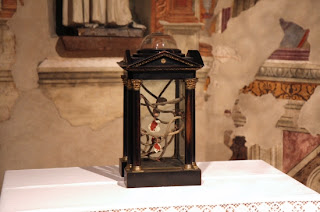Nearby to the Portiuncula is the Cappella del Transito: a small hut that served as an infirmary for the sick in the community. St. Francis died here on October 3, 1226. He asked to be brought there when he felt himself near death. The outside of the Transito is decorated with a fresco of The Death and Funeral of St. Francis by Domenico Bruschi and above the small altar is the rope belt of St. Francis in a glass case.
I got some of these pictures and my information from this site which is really informative: http://www.sacred-destinations.com/italy/assisi-santa-maria-degli-angeli, you can read more and look at more pictures if you'd like :)
We then rode the bus up to Assisi, settled into our hotel, and went to mass at San Rufino, the major church in Assisi. In this church Saint Francis, Saint Clare and many of their original disciples were baptized. It was on hearing Francis preaching in this church that Clare was deeply touched by his message and received her calling. This church also has a series of paintings by Giuseppe Afrune (born in 1954) of Pope John Paul II. His works are a particular type of unique fresco. He uses an unusual mixture of powder of carparo (a stone which can only be found in the Basso Salento area), eggs, vinegar, sugar, beef's bile, pure colors and natural resins. The mixture is spread on on a wooden surface by means of a broad knife called a "fracasso." The work is then smoothed down and when the surface is perfectly dry, it is covered with rare resins, lime water and mineral wax to make the colors brighter. These paintings were absolutely beautiful. I'm not normally very moved by art (although note: the art in Europe really was spectacular!) But this art in particular was very moving :)
The rest of the evening we went around to the shops! Assisi was probably one of my favorite places all semester. It was the most peaceful town, and I really could feel the beauty and joy of the Franciscans that lived and served there years ago. The shops were so cute and people were just the sweetest especially the shop owners. They weren't pushy about buying things. In almost every city in Europe, anytime you walked into a store, you were either watched, or actually followed. Any little show of the slightest interest in something, there was someone there to give the price and a little reason why you should buy it. I got so sick of walking into the stores many times, that often I just gave up and didn't even bother going in. Assisi was completely different, not just in terms of the shops but everything. The feel of walking into that town was a little taste of heaven :) In my opinion, Rome is the heart of the Catholic Church, and Assisi is the heart of small town Italy :)










No comments:
Post a Comment